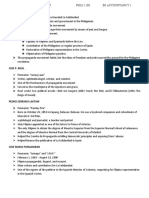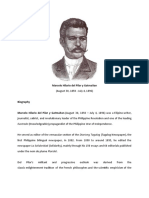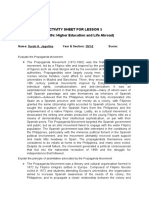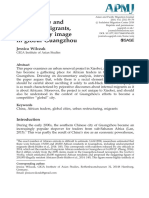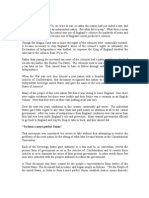0 ratings0% found this document useful (0 votes)
4 viewsPropaganda Movement
Propaganda Movement
Uploaded by
Katrina Marzanbjdgire
Copyright:
© All Rights Reserved
Available Formats
Download as PPTX, PDF, TXT or read online from Scribd
Propaganda Movement
Propaganda Movement
Uploaded by
Katrina Marzan0 ratings0% found this document useful (0 votes)
4 views50 pagesbjdgire
Original Title
PROPAGANDA-MOVEMENT
Copyright
© © All Rights Reserved
Available Formats
PPTX, PDF, TXT or read online from Scribd
Share this document
Did you find this document useful?
Is this content inappropriate?
bjdgire
Copyright:
© All Rights Reserved
Available Formats
Download as PPTX, PDF, TXT or read online from Scribd
Download as pptx, pdf, or txt
0 ratings0% found this document useful (0 votes)
4 views50 pagesPropaganda Movement
Propaganda Movement
Uploaded by
Katrina Marzanbjdgire
Copyright:
© All Rights Reserved
Available Formats
Download as PPTX, PDF, TXT or read online from Scribd
Download as pptx, pdf, or txt
You are on page 1of 50
The initiative was dubbed the
"Propaganda Revolution" in our
history. The revolution began in
1880 to 1886, but the most
important time of action is between
1880 and 1895, one year before
the death of Rizal. Propaganda
means "truth campaign and an
appeal for sympathy."
The propaganda campaign was
directed at peaceful assimilation,
leading to the transformation of the
Philippines from becoming a colony
to a province of Spain.
Propagandists claimed that if the
Philippines were Spanish citizens,
they would benefit with the same
rights and privileges. Their
advocates wanted
not independence from Spain but
reforms
Aims of Propaganda Movement were:
• Representation of the Philippines to the Cortes
Generales, the Spanish Parliament.
• Secularisation of the church
• Legalization of equality between Spain and the
Philippines
• Establishment of a public school system
independent of the Catholic friars;
• Abolition of polo y servicio (labor force) and
bandala (forced selling of local goods to the
government)
• Protection of fundamental freedoms
• Equal opportunities for the Filipinos and the
Spanish to enter the civil service
PROPAGANDA MOVEMENT
Laying the
Underground
- Doctor of Laws
Pedro Paterno and
Gregorio Sancianco,
both Chinese
mestizos endowed
with national
sentiments, made
literary works
focused on
nationalis.
- Dr. Paterno published
his first literary
“Sampaguitas” and
attempted to project
to the public a Filipino
national identity
through the works of a
Filipino
- Dr. Sancianco wrote
“El Progreso de
Filipinas” and
concluded the
inequality of the
Philippine tax
structure
- Sancianco
claimed a citizen
should
contribute to
support the state
according to his
ability but he
should not be
compelled to pay
tribute if he
owns nothing
Unifying Forces
During the
Unorganized Years
- Although they
worked individually
writing articles,
they acted as one
on certain
occasions
- Social unrest in
Spain favored the
publication of
liberal newspapers
- The Filipinos
contributed to
the cause of the
Propaganda by
establishing
“Los Dos
Mundos” were
Jaena and de
Govantes were
staff members
- By this time, the
spirit and pride of the
young propagandists
had been so stirred
that they published a
newspaper in 1887
- “Espana en Filipinas”
advocated economic
and administrative
reforms for the
Philippines
- This deliberate
assault on the dignity
of the Filipinos
stirred their national
pride and their sense
of identity
- The newspaper
had been
dissolved by
the
conservative
Spaniards that
led to a more
closer unity
among the
Filipinos
- Rizal’s Noli Me
Tangere was
published in
March 1887
- It heated
arguments
between the
pro and anti
propagandists
- Father
Salvador Font
banned the
book from
importation,
reprint and
circulation in
the
Philippines
Revival of
Activities in the
Philippines
- As the drive for
reforms in Spain
gained
momentum, the
nationalist
reformists in
the Philippines
were doing their
part
- Assisted by Basilio
Teodoro, he published
the shortlived Diariong
Tagalog
- Del Pilar secretly
organized the Comite
(Junta) Propaganda, a
small but active group
composed of Deodato
Arellano, Pedro Laktaw
and many others
- They were busy with
their anti-friar moves and
pushing the plan of
publishing their official
organ which was to be
called La Solidaridad
La Solidaridad
The reform movement was
supported by foreigners like Dr.
Miguel Morayta, the former Spanish
minister and professor and the
Austrian ethnologist Ferdinand
Blumentritt. On December 13, 1888,
an organization called "La
Solidaridad" was born
It was headed by Galicano Apacible.
Jose Rizal who was in England at
that time became its honorary
president. This organization gave
birth to La Solidaridad, the
newspaper. Its editor was Graciano
Lopez Jaena. Take note that La
Solidaridad (organization) adapted a
newspaper La Solidaridad
(newspaper).
The Soli, as the reformists fondly
called their official organ, came out
once every two weeks. The first saw
print was published on November
15, 1895. The Solidaridad’s first
editor was Graciano Lopez Jaena.
Marcelo H. del Pilar took over in
October 1889. Del Pilar managed
the Soli until it stopped publication
due to lack of funds.
Jose Rizal, Marcelo H. del
Pilar, and Mariano Ponce
comprised the main staff of
La Solidaridad. They were
called the “Glorious Trinity
of the Propaganda
Movement”
Aims of La Solidaridad
1. To work for political and social reforms
peacefully
2. To present the sad conditons in the
Philippines so that Spain can remedy
them
3. To oppose the evil influences of reaction
and outmoded beliefs and practices
4. To advocate liberal ideas and progress
5. To champion the just aspirations of the
Filipinos to life, democracy, and
happiness
Later, Asociacion
Hispano-Filipino
was inaugurated.
It composed of
Filipinos and
Spaniards who
aim for specific
reforms in the
country.
Lopez Jaena criticized
the inefficiency of the
Spanish two-party
system, lamented the
indifference of the
people to civic
projects and national
responsibility and
dealt with the
problems of the
government.
Contributors to
La Solidaridad
used pen names
to protect their
families in the
Philippines for
prosecution.
Contributor Pen name
Jose Rizal -Dimas alang
-Laong Laan
Marcelo Del Pilar -Plaridel
Lopez Jaena -Diego Laura
Jose Ma. -Jomapa
Panganiban
Antonio Luna -Taga-ilog
Mariano Ponce -Naning,
Tigbalang,
Kalipulako
Reforms they
worked for;
1.Equality of rights
and privileges
2.Assimilation of
Philippines as
province of Spain
3.Philippine
representation to
the Spanish cortes
Glimpses of
the
Propaganda
Literature
Mariano Ponce,
the managing
editor and a
regular
contributor to La
Solidaridad, was
the bibliographer
of the movement.
Jose Ma Panganiban,
who excelled in formal
and philosophical
essays, pointed out
that a government
could better
understand and
interpret the
aspirations of its
people if freedom of
the press were
granted.
The contributions of Antonio Luna to
La Solidaridad were Noche Buena, a
biological sketch that depicted actual
life in the Philippines; La Maestra de
mi Pueblo, which pointed out the
defects of the educational system for
women and a play called Todo por
Estomago, that satirized the biased
Spanish method of colonization and
taxation policies.
Marcelo del Pilar wrote La
Soberania Monacal en
Filipinas in which he set forth
the basic reform in the
Philippines; expulsion of the
friars to eliminate the
obstacles to progress in the
Philippines.
Del Pilar described the friars
in the Philippines as a
privileged and powerful
group whose powers
interfered with the political,
economic and social life and
education of the people.
They were the arbiters of
Filipino misfortunes and
their “impeccability” had
become a “dogma”.
He compared
and contrasted
the poverty of
the government
and the
opulence of the
friars who had
taken vow of
poverty.
Lopez Jaena is best
known as the orator
of the group. He used
his eloquence and
natural oratory and
held his audience
spellbound as he
expounded on the
necessity of granting
reforms for the
Filipinos.
In his oratorical homage to
Luna for having painted
“The battle of Lepanto”
that won first prize at the
Barcelona Exposition, he
defended the Filipinos
from insults and sarcastic
remarks levied by unjust
critics who were unaware
of the conditions in the
Philippines.
Jaena reacted about
a racially
discriminatory
policy of the civil
governor in
Pangasinan where
all Filipinos were
required to take off
their hats whenever
they met Spaniards.
Rizal wrote his principal
essays for La Solidaridad,
and published his
annotation of Antonio
Morga’s Sucesos de las
Islas Filipinas and his
novel El Filibusterismo
when the propaganda
movement was at its
height.
Masonry and
the
Propaganda
Movement
Not satisfied with their
research, journalistic,
literary and oratorical
feats the propagandists
joined the Brotherhood
of Masons.
Lopez Jaena
organized the
lodge
Revolucion in
Barcelona to
bring together
all Filipino
masons.
With its abolition a
year later, the Lodge
la Solidaridad was
established in Madrid
to become the center
of propaganda
activities in Spain.
Lodge Nilad
was secretly
established in
Manila by
Pedro Serrano
Laktaw.
Counter-Propaganda
moves;
Wenceslao Retana,
one of the founders
and editor of La
Politicia de Espana
en Filipinas.
He described
them as
incapable,
ignorant,
indolent, always
craving for more
rights and never
satisfied.
Francisco
Canamaque,
rememebered
the Filipinos as
childish and
culturally
backward.
Father Jose Rodriguez
wrote a series of
tracts entitled
Questiones de Sumo
Interes which
attempted to
discredit the works of
Rizal and other
propagandists.
Fr. Miguel Bustamante, in
his Si Tandang Basiong
Macunat, ridiculed the
people for aspiring to
learn the Spanish
language when they could
hardly perform their
mutual tasks
satisfactorily.
Problems of the
Propagandists
1.Inadequate financial
resources
2.Differences of opinions
3.Personal problems
began to weigh heavily
Why the Propaganda Movement
Failed?
The propaganda movement did not
succeed in its pursuit of reforms.
The colonial government did not
agree to any of its demands. Spain
itself was undergoing a lot of internal
problems all that time, which could
explain why the mother country
failed to heed the Filipino’s petitions
There were also emerging problems
of the propagandists. Most of them
have different opinions and had
personal problems. Financial
problem was also the major reason
for its downfall. Health problems and
homesickness of the reformists were
also one of the reasons why it
downgraded
.
Personal differences and
petty quarrels, apart from the
lack of funds, were also a
hindrance to the movements
success. Lastly, no other
strong and charismatic leader
emerged from the group aside
from Jose Rizal
Thank you
and
God bless
You might also like
- The Propaganda MovementDocument2 pagesThe Propaganda MovementApril CaringalNo ratings yet
- 03.08 Latin 1Document1 page03.08 Latin 1Jake86% (7)
- (Edinburgh University Press) American Thought and CultureDocument337 pages(Edinburgh University Press) American Thought and CultureJaphet TorreblancaNo ratings yet
- La SolidaridadDocument3 pagesLa SolidaridadTristan Jay NeningNo ratings yet
- Propaganda MovementDocument27 pagesPropaganda MovementvvncyangNo ratings yet
- History 7Document14 pagesHistory 7Precious Sheen RomarateNo ratings yet
- Nationalism Period 21stDocument7 pagesNationalism Period 21stoctavianojanineNo ratings yet
- Activity 7: Kyanah Therese Cajipo BSHM Mh22Document5 pagesActivity 7: Kyanah Therese Cajipo BSHM Mh22Kyanah Therese CajipoNo ratings yet
- Chapter 7 The Propaganda MovementDocument4 pagesChapter 7 The Propaganda MovementColleen Joyce CuentoNo ratings yet
- 1the Reform MovementDocument24 pages1the Reform MovementTimson LLuchNo ratings yet
- Chapter 8 Imagining A NationDocument15 pagesChapter 8 Imagining A NationFrederick Franz GarciaNo ratings yet
- Chapter 7-Campaign For Reforms-Kyna B. DavidDocument50 pagesChapter 7-Campaign For Reforms-Kyna B. DavidKBD100% (1)
- Propaganda MovementDocument2 pagesPropaganda MovementChristian Guimban0% (1)
- Presentation 1Document82 pagesPresentation 1Vonvon Sadsad100% (1)
- The Propaganda MovementDocument61 pagesThe Propaganda MovementKENTARNEL ROSAROSNo ratings yet
- The Propaganda Movement and The KatipunanDocument12 pagesThe Propaganda Movement and The KatipunanChristian Dave MativoNo ratings yet
- Why The ReformDocument16 pagesWhy The ReformMoner SiradNo ratings yet
- Filipino Drama and Novel During The Propaganda MovementDocument5 pagesFilipino Drama and Novel During The Propaganda MovementPRINCES SARAH OMBAONo ratings yet
- Propaganda MovementDocument19 pagesPropaganda MovementKarmela Mae Tan0% (1)
- Subject: Course, Year and Section: InstructorDocument6 pagesSubject: Course, Year and Section: InstructorERMAFLOR VILLANUEVANo ratings yet
- It Was A Peaceful Campaign For Reforms Towards Changing The Political and SocialDocument19 pagesIt Was A Peaceful Campaign For Reforms Towards Changing The Political and SocialNicole JunioNo ratings yet
- THE LIFE AND WORKS OF JOSE RIZAL Chapter 5 PPTXTDocument21 pagesTHE LIFE AND WORKS OF JOSE RIZAL Chapter 5 PPTXTALBIN MONTECILLONo ratings yet
- Lesson 1 - Rizal As PropagandistDocument10 pagesLesson 1 - Rizal As PropagandistHernel Sean CordaNo ratings yet
- Rizal Organizations Group 4: La Solidaridad and La Liga FilipinaDocument44 pagesRizal Organizations Group 4: La Solidaridad and La Liga FilipinaElaine Joy LacandulaNo ratings yet
- PHIL. NATIONALISM MergedDocument61 pagesPHIL. NATIONALISM MergedJohnny King ReyesNo ratings yet
- Propaganda MovementDocument29 pagesPropaganda MovementKim Flores100% (2)
- 4.1 Imagining A Nation HandoutDocument2 pages4.1 Imagining A Nation HandoutSalarda KesterNo ratings yet
- Rizal Written ReportDocument6 pagesRizal Written ReportReahmae FenizaNo ratings yet
- Chapter 5 6 Lecture StudentsDocument8 pagesChapter 5 6 Lecture StudentsLiam ElrodNo ratings yet
- The Birth of Filipino Nationalism and Propaganda MovementDocument18 pagesThe Birth of Filipino Nationalism and Propaganda MovementRonaldo Aloc100% (1)
- HIST 101 - GROUP 8 (5th Presentor)Document2 pagesHIST 101 - GROUP 8 (5th Presentor)psychstudentmegNo ratings yet
- 006 The Propaganda MovementDocument28 pages006 The Propaganda MovementJason CuregNo ratings yet
- The Katipunan Finally Starts A RevolutionDocument3 pagesThe Katipunan Finally Starts A RevolutionSa JeesNo ratings yet
- Propaganda Movement: Group 4 - ITCEDocument16 pagesPropaganda Movement: Group 4 - ITCEAdaline OralesNo ratings yet
- Research 1Document10 pagesResearch 1Xty SkyNo ratings yet
- ReadPhilHis A101Document24 pagesReadPhilHis A101Jeremi BernardoNo ratings yet
- LESSONS HistoryDocument10 pagesLESSONS HistoryLorianne ObonaNo ratings yet
- FilipinoDocument2 pagesFilipinoMe is Cheesebl0werNo ratings yet
- The SecularizationDocument16 pagesThe SecularizationmiraeNo ratings yet
- The PropagandaDocument8 pagesThe PropagandaChristine HermosoNo ratings yet
- Development of Philippine: NationalismDocument36 pagesDevelopment of Philippine: NationalismStephanie Love T. BaringNo ratings yet
- Rizals NationalismDocument9 pagesRizals NationalismJoseph MarianoNo ratings yet
- Rizal: and Filipino NationalismDocument9 pagesRizal: and Filipino NationalismGleison Bancolita100% (15)
- Imagining A NationDocument13 pagesImagining A NationGerald Bayhon100% (1)
- Propaganda MovementDocument10 pagesPropaganda MovementStephanie Mula CruzNo ratings yet
- LWR Module 8 The Propaganda Movement and La SolidaridaDocument2 pagesLWR Module 8 The Propaganda Movement and La SolidaridaSandreiAngelFloresDuralNo ratings yet
- La Liga FilipinaDocument7 pagesLa Liga FilipinaEmerson Gonzales TañaNo ratings yet
- Marcelo Hilario Del Pilar y Gatmaitan: Ilustrado (Knowledgeable) Propagandist of The Philippine War of IndependenceDocument8 pagesMarcelo Hilario Del Pilar y Gatmaitan: Ilustrado (Knowledgeable) Propagandist of The Philippine War of IndependenceJess WilmarNo ratings yet
- HistoryDocument36 pagesHistoryJ0sH GamingNo ratings yet
- Activity Sheet For Lesson 5 (Rizal's Life: Higher Education and Life Abroad)Document9 pagesActivity Sheet For Lesson 5 (Rizal's Life: Higher Education and Life Abroad)Sarah Asturias JagolinoNo ratings yet
- 3 Period of EnlightenmentDocument47 pages3 Period of Enlightenmentadrianmanuel200504No ratings yet
- Module 5 Learning Activity 1Document20 pagesModule 5 Learning Activity 1Angela Beatrice100% (1)
- Reform and Revolution in The PhilippinesDocument80 pagesReform and Revolution in The Philippinesfayliza87% (23)
- The Propaganda Movement and La SolaridadDocument18 pagesThe Propaganda Movement and La SolaridadKuen Jonica LayanNo ratings yet
- The Propaganda Movement and The KatipunanDocument45 pagesThe Propaganda Movement and The KatipunanAdam Robert LidoNo ratings yet
- Rizal in Propaganda Movement and Free MasonryDocument8 pagesRizal in Propaganda Movement and Free MasonryMa. Millen MadragaNo ratings yet
- The Propaganda Movement and La SolidaridadDocument30 pagesThe Propaganda Movement and La SolidaridadJade Alciso73% (15)
- The Propaganda Movement and La SolidaridadDocument30 pagesThe Propaganda Movement and La SolidaridadMorbid Freelance100% (1)
- The Propagandist: What Is Propagandist? and Who Are They?Document5 pagesThe Propagandist: What Is Propagandist? and Who Are They?Jayson MariñasNo ratings yet
- The Katipunan; or, The Rise and Fall of the Filipino CommuneFrom EverandThe Katipunan; or, The Rise and Fall of the Filipino CommuneNo ratings yet
- W7 8human Person Fluorishing 2.0 4Document44 pagesW7 8human Person Fluorishing 2.0 4Katrina MarzanNo ratings yet
- Challenges of The 19th CenturyDocument33 pagesChallenges of The 19th CenturyKatrina MarzanNo ratings yet
- Module 6 - Project Schedule ManagementDocument44 pagesModule 6 - Project Schedule ManagementKatrina MarzanNo ratings yet
- Week-10 231012 165344Document9 pagesWeek-10 231012 165344Katrina MarzanNo ratings yet
- Basic Motivation ConceptsDocument23 pagesBasic Motivation ConceptsKatrina MarzanNo ratings yet
- Assignment Sa Kinginang RizalDocument1 pageAssignment Sa Kinginang RizalKatrina MarzanNo ratings yet
- Adtech Module - Weeks 9-10Document15 pagesAdtech Module - Weeks 9-10Katrina MarzanNo ratings yet
- Phy Sci Lesson 7.1Document39 pagesPhy Sci Lesson 7.1Katrina MarzanNo ratings yet
- Flower Math Assessment 1Document4 pagesFlower Math Assessment 1Katrina MarzanNo ratings yet
- Entr 1013 Week 14 ModuleDocument10 pagesEntr 1013 Week 14 ModuleKatrina MarzanNo ratings yet
- ART1858-1862 FinalDocument16 pagesART1858-1862 FinalKatrina MarzanNo ratings yet
- Soc Lit Finals 1Document8 pagesSoc Lit Finals 1Katrina MarzanNo ratings yet
- Classification of OutdoorDocument22 pagesClassification of OutdoorKatrina MarzanNo ratings yet
- Modification of Terms of An Existing Financial LiabilityDocument2 pagesModification of Terms of An Existing Financial LiabilityKatrina MarzanNo ratings yet
- Lecture - Post Employment Benefits - Defined Benefit PlanDocument5 pagesLecture - Post Employment Benefits - Defined Benefit PlanKatrina MarzanNo ratings yet
- Make A MoveDocument27 pagesMake A MoveKatrina MarzanNo ratings yet
- Synod On Synodality AnswerDocument9 pagesSynod On Synodality AnswerKatrina MarzanNo ratings yet
- CJS Module 6 Non Institutional Correction Probation No LTDocument28 pagesCJS Module 6 Non Institutional Correction Probation No LTKatrina MarzanNo ratings yet
- AdvocacyDocument1 pageAdvocacyKatrina MarzanNo ratings yet
- Anderson Vs PerkinsDocument3 pagesAnderson Vs Perkinsecinue guirreisaNo ratings yet
- Made in Israel: Agricultural Export From Occupied TerritoriesDocument113 pagesMade in Israel: Agricultural Export From Occupied TerritoriesHaitham SabbahNo ratings yet
- Athens and Sparta DBQDocument4 pagesAthens and Sparta DBQapi-305320171No ratings yet
- CIVIL SOCIETY Global Civil Society PDFDocument236 pagesCIVIL SOCIETY Global Civil Society PDFDwi Fadilah Aryani100% (1)
- 'Jews For Jeremy' Chakrabarti SubmissionDocument5 pages'Jews For Jeremy' Chakrabarti SubmissionFree Speech on IsraelNo ratings yet
- Foreign Policy of PakistanDocument5 pagesForeign Policy of PakistanMmtahir MughalNo ratings yet
- Edss 300 LessonplanactivityDocument3 pagesEdss 300 Lessonplanactivityapi-509524952No ratings yet
- SK Minutes of Election MeetingDocument6 pagesSK Minutes of Election MeetingCherry Myn BumanglagNo ratings yet
- Muhammad Nejatullah SiddiqiDocument1 pageMuhammad Nejatullah SiddiqiAi Ni HajjarNo ratings yet
- Writ of Continuing Mandamus - Docx MmdaDocument3 pagesWrit of Continuing Mandamus - Docx MmdaReth GuevarraNo ratings yet
- Edfd 227 Question 4 s00142914Document8 pagesEdfd 227 Question 4 s00142914api-254146673No ratings yet
- GabbiDocument2 pagesGabbiDaniel MaurerNo ratings yet
- Expo PilipinoDocument4 pagesExpo PilipinoCee CeeNo ratings yet
- Tourism CultureDocument52 pagesTourism CultureMd. Mamun Hasan BiddutNo ratings yet
- SR# Branch Name Branch Code CityDocument8 pagesSR# Branch Name Branch Code CityRafay MustafaiNo ratings yet
- Clean, Safe and Orderly'': Migrants, Race and City Image in Global GuangzhouDocument25 pagesClean, Safe and Orderly'': Migrants, Race and City Image in Global GuangzhoucastillorocasNo ratings yet
- Good GP MaterialDocument116 pagesGood GP MaterialWen Berry Jiahui100% (1)
- CERTIFICATION No Pending CaseDocument4 pagesCERTIFICATION No Pending CaseEm MalenabNo ratings yet
- Guided Reading & Analysis: The Age of Jackson, 1824-1844 Chapter 10Document9 pagesGuided Reading & Analysis: The Age of Jackson, 1824-1844 Chapter 10kezia roblox playsNo ratings yet
- Chinas One Belt One Road - Transforming The WorldDocument7 pagesChinas One Belt One Road - Transforming The WorldFernando NogueiraNo ratings yet
- Radio Show ProposalDocument8 pagesRadio Show ProposalBibi Fahimah0% (1)
- Examens National 2bac en 2011 RDocument6 pagesExamens National 2bac en 2011 RFatima ZdNo ratings yet
- Kamraj's HistoryDocument3 pagesKamraj's HistoryAnonymous 6kkvjfx3No ratings yet
- Planilla Horas Extras Semanal OkDocument8 pagesPlanilla Horas Extras Semanal OkAdela SanchezNo ratings yet
- "თავდაცვა დღეს" #14Document4 pages"თავდაცვა დღეს" #14geoarmyNo ratings yet
- United States Corp Vs United States of AmericaDocument11 pagesUnited States Corp Vs United States of Americadoctorfingertips8529100% (2)
- Annual Gender and Development (Gad) Accomplishment ReportDocument4 pagesAnnual Gender and Development (Gad) Accomplishment ReportRoxanne PaculdarNo ratings yet
- Noufal Adika Ahmad Fauzi - 2306234986 - English B - AssignmentDocument2 pagesNoufal Adika Ahmad Fauzi - 2306234986 - English B - AssignmentNoufal AdikaNo ratings yet




